OUR BEDROOMS
At first glance, the rooms at Hotel Indigo Melbourne Little Collins feel like a calm retreat from the city. But take a closer look, and you’ll start to notice the references. Quiet details that speak to Melbourne’s layered personality.
The most obvious is behind the bed. The feature wall isn’t just decorative. It’s a reimagined map of Melbourne’s central grid. The layout is abstracted but recognisable, a patchwork of lines and angles that reflect the structured disorder of the streets below. At the heart of it, a single jewel-like light marks your location, showing the exact site of the hotel on Little Collins Street.
The idea is simple. Wherever you’re from, wherever you’re headed, this is your anchor point. A glowing reminder of where you are, and an invitation to explore what’s around you.
Step into the bathroom and you’ll notice the jewel-like stools, designed as modern tributes to Melbourne’s jewellers of the past. They add a touch of glamour while nodding to the city’s jewellery heritage, which has thrived here since the gold rush of the 1850s. Thomas Gaunt, one of the city’s earliest jewellers, created the ornate clock in the Royal Arcade that still keeps time today. These details connect the rooms to Melbourne’s long history as a luxury retail spine.
Gold accents also run through the rooms and continue into the bar and restaurant spaces. They reference both the city’s gold rush beginnings and its reputation for craft and refinement. It is a subtle thread that links the modern hotel experience to the jewellers who once traded on Bourke Street.
Each room also features murals that tell their own story. From the grace of a ballerina to the spark of fireworks, from the precision of tennis to the energy of cricket, these artworks highlight Melbourne’s vibrant cultural scene. They are visual reminders that this is a city of celebration, famous for its festivals, its creativity, and its world-class sporting events.
The furnishings continue that theme of connected storytelling. Cupboards and cabinets are designed like vintage luggage trunks, suggesting travel, discovery, and the city’s international outlook.
Other details reinforce the connection to the neighbourhood. Room numbers appear as coins, a playful reference to E. W. Cole’s famous book arcade, each one stamped with a quote that invites curiosity.
The minibar avoids the usual suspects. Instead, you’ll find a rotating selection of local spirits and snacks. Some come from Fern Bar & Dining downstairs. Others are from independent producers the team has discovered across the city.
Lighting matters too. It is soft, adjustable, and designed to give you control over the mood. Mornings feel different to evenings. The room allows you to move at your own pace, to notice the light, the sounds, the shift in energy as the city moves outside.
From the window, you catch glimpses of rooftops, laneways, and people doing everyday things. It is not a postcard view. But it is a real one.
The room does not shout for your attention. It invites it.





